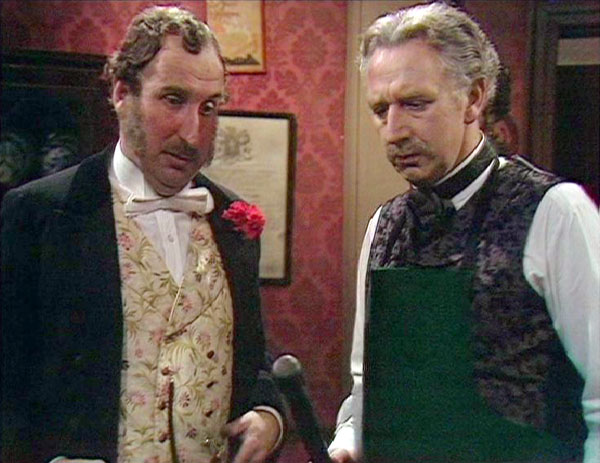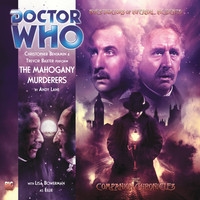Big Finish’s audio drama series, Jago and Litefoot will soon release it’s twelfth series. It follows theater owner Henry Gordon Jago (Christopher Benjamin) and pathologist George Litefoot (Trevor Baxter) as they team up as investigators of all things infernal in late 19th Century London.
What are the origins of this series and how did it become popular? The story of Jago & Litefoot is the tale of a long overdue spin-off and the freedom audio drama gives actors to play roles they would never be allowed to play in a visual medium.
In the course of the next four weeks, we’re going to take a look at the entire series over the next four articles.
The Origin

Jago and Litefoot originally appeared in the Doctor Who TV story, “The Talons of Weng-Chiang,” in 1977 which finds the Fourth Doctor (Tom Baker) and Leela (Louise Jameson) travelling back in time to the late Victorian Era. It’s a story that’s noteworthy for its period feel. The Doctor abandons his typical suit and long scarf for a Sherlock Holmes outfit complete with deer stalker cap while Leela trades her short jungle dress for a proper Victorian look. In the story, the Doctor investigates a series of strange murders and he obtains the help of Litefoot the pathologist, and Jago, whose theater is at the center of the killings. However, the Doctor meets the characters separately during his investigation and the two only come together in the last episode.
However, when they came together, the dynamic was great.They were praised as a fine double act. Writer Robert Holmes reportedly liked the idea of the two having their own spin-off series.Many fans over the years would agree, but no one at the BBC saw this as a worthwhile project and nothing came of it.
Benjamin and Baxter certainly knew little of it and didn’t work together for the next 30 years. Both had very prolific careers with a combination of stagework and television appearances. Benjamin’s career was the picture of a character actor as attested to by his 168 acting credits through IMBD. His credits read like a history of British Television with appearances in series such as Foyle’s War, the Tomorrow People, Rumpole of the Bailey, Yes, Prime Minister, and the Return of Sherlock Holmes as well as appearing as another character in the revived series of Doctor Who as a different character. Baxter’s career was no less prolific, but it was focused more on the stage and included play writing as well as appearances in a few films.
By 2009, Benjamin was 74, and Baxter 76. It was safe to say their time on a Victorian Doctor Who serial was little more than a happy memory for them.
The Pilot

Benjamin and Baxter worked together for the first time in more than thirty years on the Mahogany Murderers, which was released by Big Finish in June 2009. The story was officially released as part of Big Finish’s Companion Chronicles line of audiobooks. The Mahogany Murderers was strikingly different than other releases in this line as it was not really an audiobook, but a two-handed audio drama and it became a backdoor pilot for the series. In addition, despite featuring the Doctor Who theme music, the Doctor doesn’t appear.
The plot involves Jago and Litefoot meeting up at the Red Tavern and telling each other about strange encounters they had. For Professor Litefoot, the case begins to get strange when a body is pulled from the Thames and turns out to be a very well-detailed mannequin or is it?
It actually proves to be a part of a plot by a gang of criminals who want to live forever, and they are assisted by the mad genius, Doctor Tulp.
The story is brilliantly acted as Jago and Litefoot recount the tale with gusto. The story becomes more complex and creepy as it develops and the truly diabolic nature of the business is revealed.
The release was a critical and commercial success. It showed the potential for a series of Jago and Litefoot adventures.
The Series Begins
The Jago & Litefoot series has had a very consistent feel to it over the course of the last eleven box sets, aided by the continuing presence of most of its key principles. The series is produced by David Richardson, with scripts edited by Justin Richards, and\ directed by Lisa Bowerman.
In The Mahogany Murderers, Bowerman took on the functional role of the minor character, Ellie Higdson, the barmaid. The role grew to become the main supporting character through the entire series. Conrad Asquith, who played Police Constable Quick in the Talons of Weng-Chiang, reprized the role as Sergeant and later Inspector Quick in every box set except for Series 5.
The cast and the creative team were in place and thirteen months after the Mahogany Murderers was released Jago & Litefoot released their first series box set. Each box set would contain four stories, written by three or usually four different writers. Details of the first two series with minimal spoilers follow.
In this first series, the show is very entertaining but it’s clearly trying to find its feet. While there was a single villain behind the scenes, each story has a different flavor as there’s a sense of trying to discover what works best. The first story “The Bloodless Soldier” is a werewolf tale and it’s followed by “The Bellova Devil” which is a more traditional detective mystery, then “The Spirit Trap” has them taking on what they think is a phony medium but who turns out to be far more dangerous than they imagined, and then wraps up with “The Similarity Engine,” which has a very strong steampunk feel to it.
The series set down a few key precedents. Because it is set in the same universe as Doctor Who, the infernal things that Jago and Litefoot investigate will tend to have causes that are naturalistic, alien, or mad science related. Even if there’s a werewolf, the series will offer a natural explanation for it rather than suggest an ancient curse or something of that sort.
The first series also had to be concerned with the character development of Jago. Jago has endearing traits that make him a fun supporting character but that could pose a problem as a lead. Jago can be a pompous and is almost always the over the top impresario ready to drop a grand alliteration, such as, ‘Slumbering somnambulists to the slaughter!’ In addition, if written in the wrong way, Jago could easily be one dimensional and the teaming of Jago and Litefoot would be that of the erudite Litefoot and blustering cowardly idiot Jago.
The series chose to go another direction and right from the first episode, Jago is established as something different. Jago faces a fateful decision, a moment of truth at the end of “The Bloodless Soldier,” that forces him to take action and spurs his journey towards being a believable hero of the story. And rather than Litefoot being smart and Jago being dumb, the series establishes the duo as complimentary. Litefoot is better read and expert in scientific investigation, however Jago’s years of experience in the theater have brought him a specialized skillset and a sort of street smarts that helps him catch things Litefoot might miss.
Overall, the first series does a great job of laying the groundwork for the whole Jago & Litefoot audiodrama.
In the Winter of 2011, Series 2 of Jago and Litefoot was released. This second series had a much darker feel. It kicked off with Litefoot abandoning Jago for a new partner in Gabriel Sanders in “Litefoot and Sanders.” After killing off Ellie’s brother in the Series 1 opener, Ellie herself dies in the opening story and our heroes take a spooky night train to ensure the safe burial of her remains only to discover foul experiment afoot among the bodies in, “The Necropolis Express.” In “The Theatre of Dreams,” Jago books an act that can make your dreams come true but of course, this promise has a dark side. Finally, in “The Ruthaven Inheritance,” Litefoot is fired and Jago is tricked into selling his theatre. Both men get 500 pounds and the villain’s endgame comes into play.
“The Theatre of Dreams” is probably the outstanding story of the series with its mind-bending plot and the way it challenged listeners’ perceptions. The series strengthened the relationship between Ellie and our heroes. They show obvious care for her. When they find out she’s not really dead but has been transformed into a vampire by the villain of the story, Litefoot sets out to cure her and Jago takes care of her despite her making him nervous. Her vampirism is gone by the end of the series but some of the after effects play a role in Jago and Litefoot stories for years to come.
On a negative side, the final story put Ellie, Jago, and Litefoot in serious straits and the finale offers cheap solutions that aren’t entirely satisfying. In addition, the tone of the stories was too dark for the lead characters, particularly in the second box set.The first two box sets were well-written but it’d be hard to describe the series as fun. The series had some strong stories but they needed to find the right tone. They’d take a big step towards that in Series 3 and they’d do it with some old friends and new writers. We’ll talk about that next week.
This post contains affiliate links, which means that items purchased from these links may result in a commission being paid to the author of this post at no extra cost to the purchaser..
If you enjoyed this post, you can have new posts about Detective stories and the golden age of radio and television delivered automatically to your Kindle.

4 comments for “A Look at Jago & Litefoot, Part One”